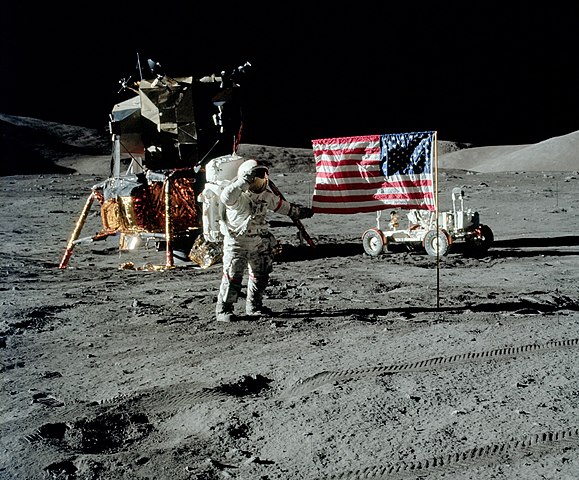
What was the last Apollo mission? The last Apollo mission was Apollo 17.
The Apollo program stretched from 1967 until 1972. There was supposed to be an Apollo 18, 19, and 20 but they were all cancelled. The booster for Apollo 20 was repurposed to launch Skylab, America’s first space station into orbit. The decision to cancel the last few missions was taken in 1970, after Congress cut NASA’s budget. There is some evidence that after the Apollo 13 catastrophe and rescue, President Nixon wanted to cancel Apollo 17 as well.
The Apollo space program took over after the Gemini and Mercury programs which had worked to build rockets capable of orbit and putting people in orbit. The first Apollo mission, Apollo 1, was meant to launch in 1967, but it unfortunately never flew because a fire in the cabin tragically killed the crew. The next Apollo rocket to fly was number 4 and that, followed by 5 and 6 were all unmanned and were used to test out different systems. Apollo 7 was crewed and orbited the Earth. Apollo 8 orbited the moon. Apollo 9 orbited the moon and tested out life support systems. Apollo 10 sent a Landing Module down within 15 km of the moon’s surface as a test and flew home. That must have been hard for them not to go the last little bit. Apollo 11, as I’m sure you are aware, landed on the moon. Apollo landed on the moon. Apollo 13 had several problems and didn’t get to land on the moon. The Apollos 14, 15, 16, and 17 all successfully landed on the moon and returned. Apollo 17 was the last one and Gene Cernan was the 11th and last person to walk on the moon. So far.
So, why was Apollo 17 the last mission to the moon? The main reason was money. NASA was started in 1958, when President Eisenhower signed it into being. After World War 2 and the Korean War, the Department of Defense had become very interested in upper atmosphere rockets and they wanted to launch orbital satellites. High speed planes were being built that could fly at the edge of space. Russia had launched sputnik in 1957, and America felt that it was getting left behind. Every time America made a technological advance, they found that the Russians had already beaten them to it. Later on, they would find out that the Russian space program was basically held together with chewing gum, but they didn’t know that at the time and there was a desperate feeling of losing to Russia. JFK tapped into this when he became President and used it in his famous, “We choose to go to the moon … because [it] is hard,” speech. And NASA was basically given a blank check.
From the beginning of the Apollo project until the end, NASA spent $28 billion, which is $280 billion when adjusted for inflation. This seemed like a good deal while America was trying to beat Russia, but once the race was won, people couldn’t see the need to keep spending so much money. There were so many other things the money could be spent on. The late 1960s were much harder for people than the early 1960s. The growth after the end of World War 2 had started to slow. Inflation was beginning to rise, and the dollar wasn’t as strong as it had been. The Vietnam War was picking up and social problems in America were coming to the fore. Getting people on the moon was no longer a priority.
People had lost interest in the space program as well. It had been a source of national pride during the space race, but now that was over, people weren’t interested. Space flights and moon walks were not broadcast on TV, and without public opinion behind them, NASA couldn’t get funding. And without funding, there was no way to get more people on the moon.
The goals of space flight changed as well. The purpose of all 6 of the Apollo missions that landed on the moon was experimentation and geology. They wanted to know all they could about the moon. To that end, the crew of Apollo 17 were scientists and geologists. By Apollo 17, NASA realized they had learned everything they needed to learn from the surface of the moon and experiments in space could be carried out from far cheaper space stations in orbit around the Earth.
When Congress cut NASA’s funding in 1970, they had to make choices. They could continue with the moon landing planned for Apollo 18, or they could use the money for several other projects that would have more value. They obviously chose the other projects and Apollo 18 was abandoned. After Apollo 11, though, all future trips to the moon were basically doomed because they cost too much, and people weren’t interested once the race with Russia had been won. And this is what I learned today.
Image By Harrison Schmitt – https://www.hq.nasa.gov/alsj/a17/AS17-134-20378HR.jpg, Public Domain, https://commons.wikimedia.org/w/index.php?curid=113250319
Sources
https://www.historycentral.com/sixty/Economics/Overview.html
https://www.planetary.org/space-policy/cost-of-apollo
https://www.jfklibrary.org/visit-museum/exhibits/past-exhibits/moon-shot-jfk-and-space-exploration
https://www.popsci.com/blog-network/vintage-space/what-happened-apollos-2-and-3/
https://www.nasa.gov/specials/60counting/begin.html
https://airandspace.si.edu/stories/editorial/why-did-we-stop-going-moon
https://en.wikipedia.org/wiki/Apollo_program
https://en.wikipedia.org/wiki/Apollo_17
https://www.rmg.co.uk/stories/topics/why-did-we-stop-going-moon
